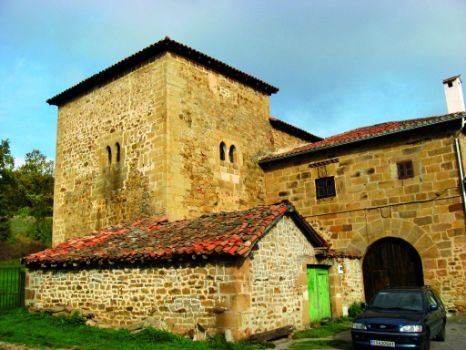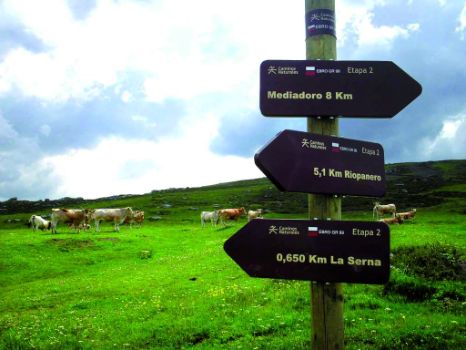Net of Natural
Trails

Stage 2: Montes Claros - Villanueva de la Nía
Description
The route begins at the Monastery of Montes Claros (970 m), from where it heads down to the railway stop of Montes Claros by a paved track. After crossing the railway tracks, there are two alternative routes. One heads down to the bridge over the Ebro, near Bustasur. The other continues ahead, through pines and beeches, until it joins the route across the bridge. The track heads through beeches, pines, oaks and Portuguese oaks for one kilometre until it joins the route across the bridge. From here, the route continues along the river flanked by alders and willows. The area is included in the National Inventory of Habitats. After skirting around a hill, and past the towns of Valdeteje and El Hoyo, the route passes next to a cluster of derelict buildings. Further on, Baños de Aldea de Ebro appears to the left, surrounded by huge pines.
Past the Roblayoso Bridge, there is a paved track on the left bank of the Ebro that runs through oak trees, and leads to Rabiquis Bridge, where the route crosses Albergue Brook. Here begins the climb up to Aldea de Ebro (5.7 km, 1hr 20min). To the south, near the fountain with a drinking trough, starts the old road to Loma Somera. Initially, it runs through farms, flanked by Portuguese oaks, with views of the road and the shrine of Dondevilla. Soon the level ground gives way to a steep slope that traverses through Los Tricherios oak forest.

There are good views of the Ebro and its surroundings from the summit. The GR descends through magnificent stands of oaks and beeches, then crosses Costeriza Brook. It again climbs towards a wide summer meadow overlooking Mount Cabrero. Further on, the route ventures into another oak forest, next to a stone wall, which leads to Loma Somera.
The route continues along a gravel track, next to a church, and climbs down along Isilla towards the second bend to the left, whence the old dirt road to La Renegada mill begins (12 km, 3hr 15 min). This road traverses through walls, fields, cobbled paths and gall oaks. Parallel to the river, through oaks, beeches and poplars, the route winds towards a bridge over the Ebro that leads to Aroco on the opposite side.
Without entering the village, the route follows an old road through fields, pastures and grazing cattle. The route continues through level gall oak woodlands enclosed by stone walls that are, occasionally, traversed by cobbled paths. It now begins to climb El Coladillo (808 m) towards the summit, whence there are good views of Aroco, the Ebro and the surrounding mountains.

Looking towards Bárcena de Ebro to the northwest, one can see the town of Reocín de los Molinos and the road that crosses the valley. The route descends towards Bárcena through gall oaks (15.7 km, 4hr 15min).
After a short stretch along the road to Loma Somera and Bustillo del Monte, the route takes a path to the right, before the intersection. This road leads up Mount La Lechosa, through oaks and reforestation pines, to Las Llanas summer meadow, dotted also with oaks. The road, which is now a track, leads to Otero del Monte, past Campa Llana (19.4 km, 5hr 25min).
The GR 99 leaves this town behind and continues along a paved road to the Romanesque church on the outskirts. A path to the right ventures into a gall oak forest and comes upon another paved road that heads down to Cubillo de Ebro, with views of Villanueva de la Nía. The route leaves the town by road and a path through gall oaks. It crosses the old bridge over the Ebro and enters into the town, where this Section ends at the bridge over the Molino Mardancho Brook (725 m, 24 km, 6hr 30min).
Entidades gestoras:
- Ministerio de Agricultura, Pesca y Alimentación
Puntos de interés
Culture
Municipality
Profile

Highlights
Further information
Heritage
All the towns included in this Section have interesting examples of typical mountain architecture, as well as notable monuments. In Aldea de Ebro, designated a Historic Rural Site, there are emblazoned houses, the church of San Juan Bautista with an interesting “standalone” steeple (13th century), and the Romanesque shrine of Dondevilla. The hamlet of Bárcena de Ebro is also famous for its robust towers, defensive systems, two bridges, and a steepled church. The parish churches of Aroco (16th C.), Cubillo de Ebro (17th C.) and Villanueva de la Nía (12th C.), with interesting corbels, as well as several modern palaces are also noteworthy.




